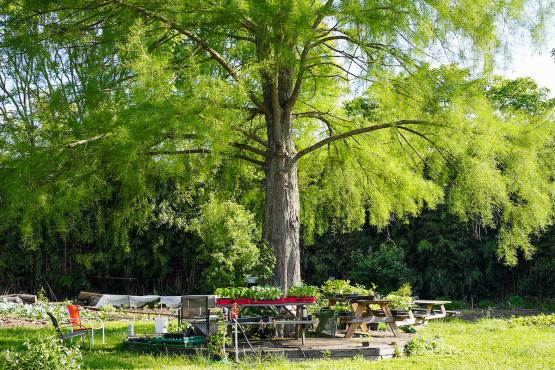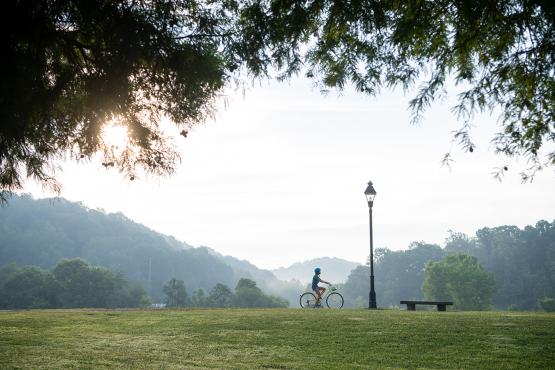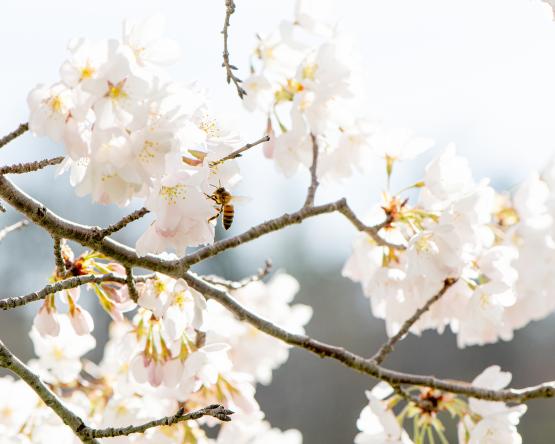
Transforming food waste into nutrient-rich soil: OHIO’s Compost Facility provides an educational model for comprehensive sustainability
Since 2009, Ohio University has been home to the largest in-vessel composting system at any college or university in the nation. The facility allows OHIO to compost nearly 100% of food waste from dining halls and food facilities and serves as an educational model--providing students with a look at what’s possible in the realm of sustainability.
Alex Semancik | April 17, 2025
Share:
Every day the Ohio University Compost Facility processes more than five tons of food waste. In four to five months, what most would consider garbage is transformed into the nutrient-rich soil used for campus landscaping.
Each ton of waste that the Ohio University Compost Facility processes is a ton diverted from landfills where discarded food can become buried under other solid waste and create harmful methane emissions that contribute to climate warming. In this way, composting is a circular process where waste material is kept in circulation and reused rather than discarded.
“Food comes out of the ground, we eat it, we process it, we throw it away, we compost it, and then we return it to the ground. It’s a very circular process,” said Ohio University Director of Sustainability Sam Crowl. “The problem with having food waste in the landfill is all that organic material gets buried, and researchers tell me that when it's about a meter deep it attracts bacteria that produce methane gas. That's the greenhouse gas we're trying to avoid by doing this whole process.”
Beyond being good for the environment, OHIO’s Compost Facility also serves as an important educational model—spreading awareness of sustainable practices, allowing students to witness a circular process first-hand and providing them with a big-picture look at what’s possible in the realm of sustainability.
Ohio University’s composting process
Since 2009, Ohio University has been home to the largest in-vessel composting system at any college or university in the nation. In-vessel refers to the indoor composting of food waste in large containers which helps ensure the process is effective at churning out quality soil while also limiting any chance of methane-producing bacteria. The OHIO facility contains a two-ton and four-ton in-vessel system from Wright Environmental Management Inc.
The OHIO facility is managed by Facilities Management and Safety and the Office of Sustainability and operates at the south side The Ridges. It is a “Class II Compost” facility meaning it can accept food and yard waste, and it operates year-round with only two full-time staff members.
The process starts how all compost does—with food waste. Dozens of compost bins can be found around campus at University dining halls, central food facility, various offices and even some residence halls via an opt-in composting program. In most dining halls, any leftover food is placed on a conveyor belt where a Culinary Services employee separates the contents: food waste, landfill waste and recyclable waste. This collection process allows the University to compost nearly 100% of food waste from campus dining halls and central food facility.
“Culinary Services has been a really great partner of ours,” said Crowl. “They have achieved national recognition for the low amount of waste that they have in their processes and part of that is because we are able to recover all the waste that they have and include it in [the composting] process.”
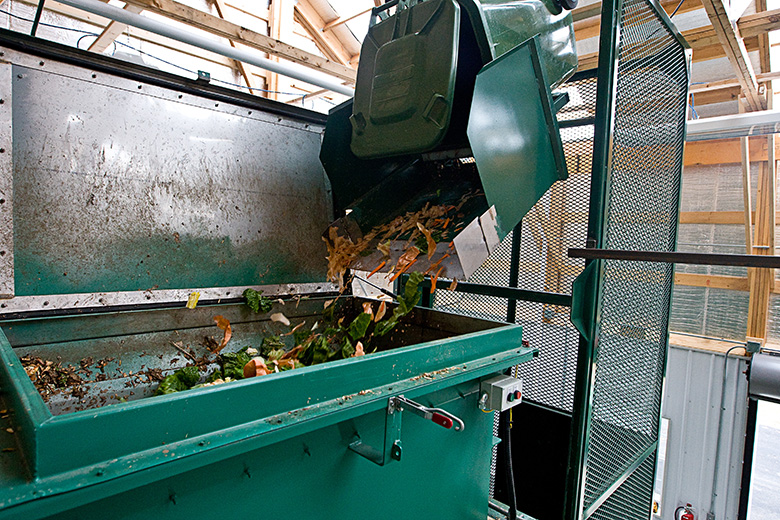
An elevator shaft pours food waste into a composting vessel.

Some of the woodchips utilized in OHIO's food waste composting process come from the University's second Class IV compost facility that specializes in breaking down yard waste.

To ensure that all food waste data is recorded, each individual compost bin is weighed before being dumped into the composting vessels.
Compost bins are collected five days a week and taken to the facility where they are weighed for data collection purposes then raised up and dumped into one of the two vessels. The fruit and vegetable scraps, coffee grounds, eggshells and other organic waste are then mixed with wood chips to create a chemically balanced mixture. This mixture is constantly turned and heated to create an oxygen-rich environment that aids the decomposition process and further reduces bad bacteria.
“In order for that decomposition process to happen, you need nitrogen and carbon,” explained Crowl. “There's plenty of nitrogen in the food waste, but we need carbon, and so the wood chips are added at roughly 40% to 60%. It's about 40% woodchips to 60% food waste.”
After spending around two weeks moving through various zones in the vessel, the resulting material is taken outside where it is cured in long outdoor piles called windrows for 90 to 180 days. While curing, the piles are still turned to keep them sufficiently oxygenated. A windrow turner hitched to a tractor is pulled across the rows to flip the whole compost pile in only about 10 minutes. In the windrows, the composted material starts to resemble the high-quality soil that will eventually be used around campus in flowerbeds, gardens, trees and intramural fields—no fertilizer required.

Windrow compost piles cure next to the compost facility. Windrows were previously turned using a backhoe, a process that would take more than hour before the windrow turner was purchased with grant funding.
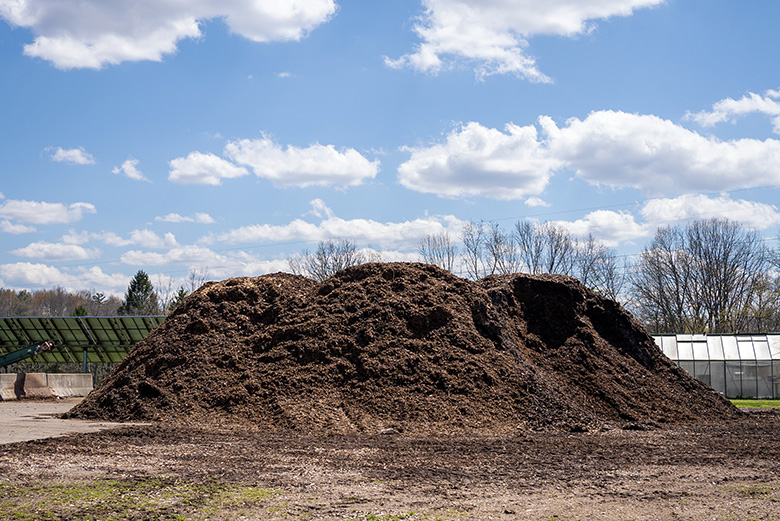
Ohio University's compost soil is available for purchase at Bobcat Depot, but the University is able to use most of what it produces.
A comprehensive sustainability experiment
While the act of composting itself benefits people, the planet and prosperity now and in the future, each facet of the Ohio University Compost Facility was also designed with sustainability in mind. The facility produces renewable energy through solar panels, collects rainwater for cleaning and utilizes a waste oil burner for heat during the colder winter months. Crowl says this spirit of sustainability at OHIO goes back decades with the University being the first public institution in the state to create a sustainability office in 2005.
“The Sustainability Director at the time who wrote the grants for [the compost facility]—Sonia Marcus—thought about things like ‘we have all this food waste, how can we better manage this resource,’” emphasized Crowl. “She tried to think about the entire building as a sort of sustainability experiment. I'm always impressed with all the different pieces they really thought of.”
The two pole barns that make up the compost facility utilize natural light via plastic skylights on the ceiling. The sunlight that pours in from the skylights sufficiently lights the buildings and eliminates the need for additional electricity usage. What electricity the building does need to operate comes from rows of Kokosing Inc., solar panels that cover the building.
“We have a lot of solar panels on the property,” said Crowl. “It is grid tied, so that electricity is going into the grid but it offsets pretty much 100% of what we need to run the facility.”
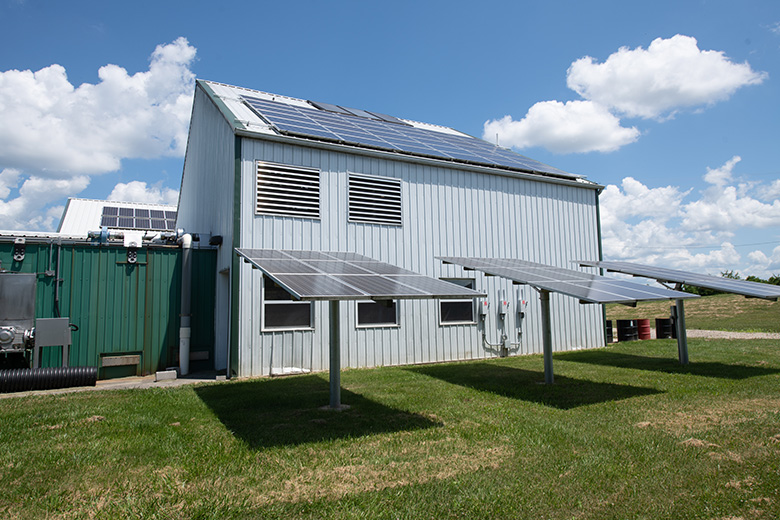
The top-most three solar panels are part of a solar-thermal system. A glycol solution runs through piping in the panels which allows them to harness the sun's heat.
Some of the solar panels also make up a specialized solar-thermal system that utilizes powerful sunlight to heat the rainwater for more effective cleaning. All the rainwater that falls onto the roofs of both buildings is collected via a system of gutters and pipes, sent through a biofilter composed of wood chips, sand and gravel, then stored in an underground cistern that is heated by coils connected to the solar-thermal system. Crowl says this water collection method allows the facility to be even more sustainable, as well as conserve resources.
“All of these [compost] bins have to go back into the dining halls to be used again, and the health code requires them to be totally clean, so we had to figure out how can we best clean them appropriately,” explained Crowl. “So, the staff built this rack and set up this power washing system that uses rainwater to clean the bins.”
Rather than use electricity to heat the building, a waste oil burner was installed to keep the compost facility warm during the colder months. Waste oil from machinery and mechanical processes on campus is collected when it is no longer viable, recycled and brought up to the south side of The Ridges to be burned for heat.

Compost bins are collected five days a week, year-round.
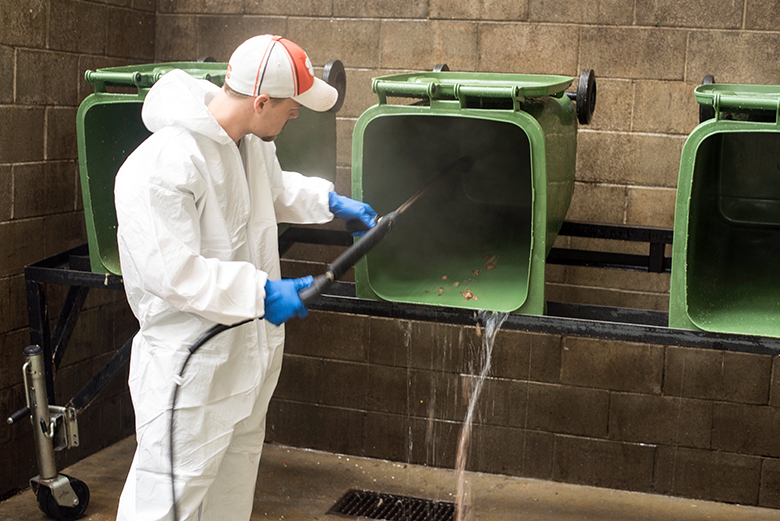
All Ohio University compost bins are power-washed with recycled rainwater before being returned to the dining halls.
An educational model
The Ohio University Compost Facility is a glowing example of comprehensive sustainability that faculty take full advantage of. Through classes in subjects like environmental studies and sustainability, as well as tours, students and community members learn about the compost facility and are exposed to sustainable practices firsthand.
“I love taking students up here just because it's this kind of comprehensive look at sustainability,” emphasized Crowl. “I open it for tours, I do a lot of tours for the community, local school groups, clubs at Ohio University and for other professors who are talking about these issues like in engineering and civil engineering.”
Walking people through the facility and how composting works helps them see what Crowl describes as the bigger picture and the circular nature of the process.
“It really helps students to say, oh, I get it,” said Crowl. “We tend to purchase things and we throw them away, but there is no place that's called 'away' where it just disappears. It has to be managed somewhere, most of it ends up in a landfill. And so, it's really easy when you explain to students ‘I'm just trying to take this material that came from the ground—we get to eat it, we don't need all of it, that's okay—let's return it, let's just create something new out of it.’”


